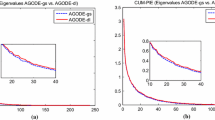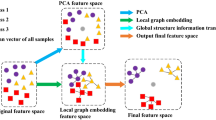Abstract
Recently, sparse representation (SR) based graph has been successfully applied for dimensionality reduction (DR). However, the unsupervised characteristic of SR may cause instable representation results, which is undesired for graph construction. To alleviate the problem, a robust weighted group sparse representation (RWGSR) method is developed by minimizing the combination of l1-norm regularized representation fidelity and the weighted l2,1-norm regularized representation coefficients. RWGSR can find the robust and stable intrinsic intra-class and inter-class adjacent relations of samples. The intra-class and inter-class representations of RWGSR are then utilized to construct corresponding intra-class and inter-class graphs. With the graphs, a novel supervised DR algorithm named robust weighted group sparse graph based embedding (RWGSE) is proposed. Benefitting from RWGSR, RWGSE considers both intra-class and inter-class intrinsic structures of data, and seeks a low-dimensional subspace by simultaneously minimizing the intra-class scatter and maximizing the inter-class scatter. Extensive experiments on public benchmark face and object datasets show the effectiveness of the proposed method.

















Similar content being viewed by others
References
Zhang L, Zhang D (2016) Visual understanding via multi-feature shared learning with global consistency. IEEE Trans Multimed 18(2):247–259
Sha C, Zhao H (2017) Design and analysis of associative memories based on external inputs of continuous bidirectional associative networks. Neurocomputing 266:433–444
Zhang L, Zhang D (2017) Evolutionary cost-sensitive extreme learning machine. IEEE Trans Neural Netw Learn Syst 28(12):3045–3060
Donoho DL, et al (2000) High-dimensional data analysis: the curses and blessings of dimensionality. In: AMS math challenges lecture, pp 1–32
Zhang L, Zhang D (2015) Domain adaptation extreme learning machines for drift compensation in E-nose systems. IEEE Trans Instrum Meas 64(7):1790–1801
Wang L, Chen S (2017) Joint representation classification for collective face recognition. Pattern Recognit 63(5):182–192
Zhang Q, Deng K, Chu T (2016) Sparsity induced locality preserving projection approaches for dimensionality reduction. Neurocomputing 200(C):35–46
Kasun LLC, Yang Y, Huang GB et al (2016) Dimension reduction with extreme learning machine. IEEE Trans Image Process 25(8):1–1
Wold S, Esbensen K, Geladi P (1987) Principal component analysis. Chemometr Intell Lab Syst 2(1):37–52
Belhumeur P, Hespanha J, Kriegman D (1997) Eigenfaces vs. fisherfaces: recognition using class specific linear projection. IEEE Trans Pattern Anal Mach Intell 19(7):711–720
Lu GF, Zou J, Wang Y (2016) A new and fast implementation of orthogonal LDA algorithm and its incremental extension. Neural Process Lett 43(3):687–707
Lu GF, Wang Y, Zou J (2016) Graph maximum margin criterion for face recognition. Neural Process Lett 44(2):1–19
Tenenbaum JB, Silva VD, Langford JC (2000) A global geometric framework for nonlinear dimensionality reduction. Science 290(5500):2319–2323
Roweis ST, Saul LK (2000) Nonlinear dimensionality reduction by locally linear embedding. Science 290(5500):2323–2326
Belkin M, Niyogi P (2001) Laplacian eigenmaps and spectral techniques for embedding and clustering. In: Proceedings of the 14th international conference on neural information processing systems: natural and synthetic, Vancouver, British Columbia, Canada, 03–08 Dec 2001, pp 585–591
He X, Niyogi P (2002) Locality preserving projections. Adv Neural Inf Process Syst 16(1):186–197
He X, Cai D, Yan S, Zhang H-J (2005) Neighborhood preserving embedding. In: The 10th IEEE international conference on computer vision, 2005, vol 2. IEEE, Beijing, pp 1208–1213
Yan S, Xu D, Zhang B, Zhang H-J (2007) Graph embedding and extensions: a general framework for dimensionality reduction. IEEE Trans Pattern Anal Mach Intell 29(1):40–51
Sugiyama M (2007) Dimensionality reduction of multimodal labeled data by local Fisher discriminant analysis. J Mach Learn Res 8(1):1027–1061
Wright J, Ma Y, Mairal J, Sapiro G, Huang TS, Yan SC (2010) Sparse representation for computer vision and pattern recognition. Proc IEEE 98:1031–1044
Cheng B, Yang J, Yan S et al (2010) Learning with l 1-graph for image analysis. IEEE Trans Image Process 19(4):858–866
Qiao L, Chen S, Tan X (2010) Sparsity preserving projections with applications to face recognition. Pattern Recognit 43(1):331–341
Wei L, Xu F, Wu A (2013) Weighted discriminative sparsity preserving embedding for face recognition. Knowl Based Syst 57(2):136–145
Huang H, Yang M (2015) Dimensionality reduction of hyperspectral images with sparse discriminant Embedding. IEEE Trans Geosci Remote Sens 53(9):5160–5169
Zang F, Zhang JS (2011) Discriminative learning by sparse representation for classification. Neurocomputing 74:2176–2183
Lu GF, Jin Z, Zou J (2012) Face recognition using discriminant sparsity neighborhood preserving Embedding. Knowl Based Syst 31:119–127
Lai J, Jiang X (2016) Classwise sparse and collaborative patch representation for face recognition. IEEE Trans Image Process 25(7):3261–3272
Grave É, Obozinski G, Bach F (2011) Trace lasso: a trace norm regularization for correlated designs. In: Proceedings of the 24th international conference on neural information processing systems, Granada, Spain, 12–15 Dec 2011, pp 2187–2195
Wright J, Yang AY, Ganesh A et al (2008) Robust face recognition via sparse representation. IEEE Trans Pattern Anal Mach Intell 31(2):210–227
He W, Zhang H, Zhang L et al (2017) Weighted sparse graph based dimensionality reduction for Hyperspectral images. IEEE Geosci Remote Sens Lett 13(5):686–690
Elhamifar E, Vidal R (2013) Sparse subspace clustering: algorithm, theory, and applications. IEEE Trans Pattern Anal Mach Intell 35(11):2765–2781
Guo T, Zhang L, Tan X (2017) Neuron pruning-based discriminative extreme learning machine for pattern classification. Cognit Comput 9(4):581–595
Ly NH, Qian D, Fowler JE (2014) Sparse graph-based discriminant analysis for hyperspectral imagery. IEEE Trans Geosci Remote Sens 52(7):3872–3884
Gao S, Tsang WH, Chia LT (2013) Laplacian sparse coding, hypergraph laplacian sparse coding, and applications. IEEE Trans Pattern Anal Mach Intell 35(1):92–104
Yuan M, Lin Y (2006) Model selection and estimation in regression with grouped variables. J R Stat Soc Ser B (Stat Methodol) 68(1):49–67
Yang J, Wright J, Huang T, Ma Y (2010) Image super-resolution via sparse representation of raw patches. IEEE Trans Image Process 19(11):2861–2873
Zhang L, Zhang D (2016) Robust visual knowledge transfer via extreme learning machine based domain adaptation. IEEE Trans Image Process 25(10):4959–4973
Zhang L, Zuo W, Zhang D (2016) LSDT: latent sparse domain transfer learning for visual adaptation. IEEE Trans Image Process 25(3):1177–1191
Xu Y, Fang X, Wu J et al (2015) Discriminative transfer subspace learning via low-rank and sparse representation. IEEE Trans Image Process 25(2):850–863
Donoho D (2006) For most large underdetermined systems of linear equations the minimal l1-norm solution is also the sparsest solution. Commun Pure Appl Math 59(6):797–829
Tibshirani R (1996) Regression shrinkage and selection via the lasso. J R Stat Soc Ser B (Methodol) 58(1):267–288
Lin Z, Chen M, Wu L, Ma Y (2009) The augmented Lagrange multiplier method for exact recovery of corrupted low-rank matrices, UIUC. Technical Report, UILU-ENG-09-2215
Deng W, Yin W, Zhang Y (2011) Group sparse optimization by alternating direction method. Department of Computational and Applied Mathematics, Rice University, Houston, Technical Report, TR11-06
Cai D, He X, Han J, Zhang H-J (2006) Orthogonal laplacianfaces for face recognition. IEEE Trans Image Process 15(11):3608–3614
Georghiades AS, Belhumeur PN, Kriegman DJ (2001) From few to many: illumination cone models for face recognition under variable lighting and pose. IEEE Trans Pattern Anal Mach Intell 23(6):643–660
Sim T, Baker S, Bsat M (2003) The CMU pose, illumination, and expression database. IEEE Trans Pattern Anal Mach Intell 25(12):1615–1618
Nene SA, Nayar SK, Murase H (1996) Columbia object image library (COIL-20). Technical Report, CUCS-005-96
Acknowledgements
The authors would like to thank the anonymous reviewers and the editors for their valuable suggestions. This work was supported by the National Natural Science Foundation of China (Nos. 61571069, 61771079), Chongqing University Postgraduates’ Innovation Project (No. CYB15030), and in part by the Fundamental Research Funds for the Central Universities (Nos. 106112017CDJQJ168817, 106112017CDJQJ168819).
Author information
Authors and Affiliations
Corresponding author
Rights and permissions
About this article
Cite this article
Guo, T., Tan, X., Zhang, L. et al. Learning Robust Weighted Group Sparse Graph for Discriminant Visual Analysis. Neural Process Lett 49, 203–226 (2019). https://doi.org/10.1007/s11063-018-9809-5
Published:
Issue Date:
DOI: https://doi.org/10.1007/s11063-018-9809-5




